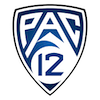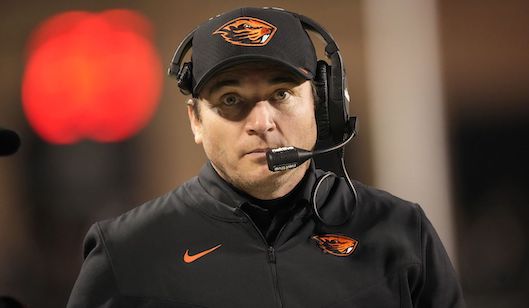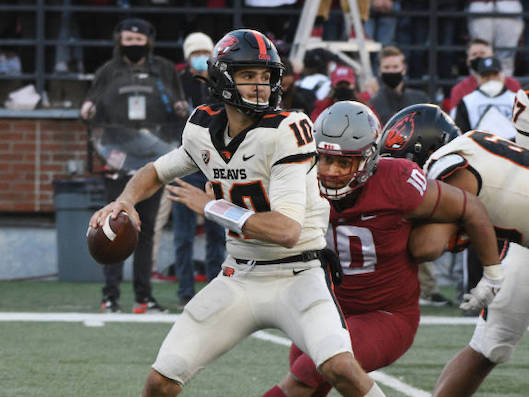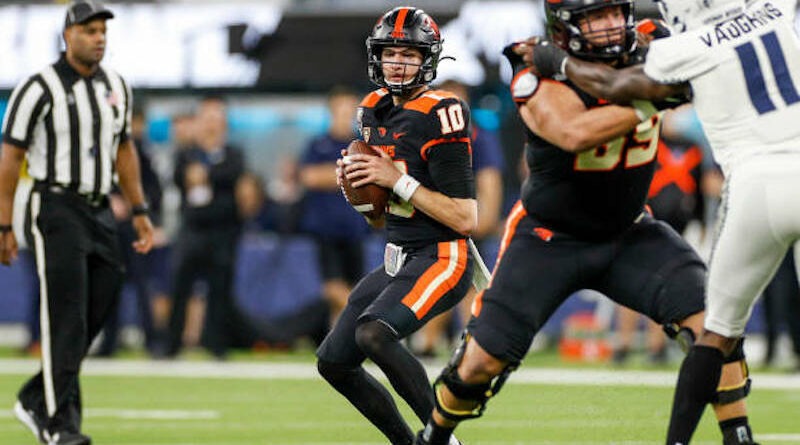
By Dane Miller, SuperWest Sports
August 8, 2022
This Oregon State preseason football preview is the 10th of 12 to appear over as many weeks as we count down the days to the start of the 2022 Pac-12 season on September 1st.
 Each preview consists of nine sections: Overview, Best-Case Scenario, Worst-Case Scenario, What Should Happen, What Must Happen, Greatest Strength, Biggest Concern, Deciding Factors, and Schedule Analysis.
Each preview consists of nine sections: Overview, Best-Case Scenario, Worst-Case Scenario, What Should Happen, What Must Happen, Greatest Strength, Biggest Concern, Deciding Factors, and Schedule Analysis.
Nothing is set in stone, however, as rosters and depth charts continue to evolve over the summer.
• 2021 Record: 7-6, 5-4
• Head Coach: Jonathan Smith (16-28 in four years at OSU)
• Offensive Coordinator: Brian Lindgren
• Defensive Coordinator: Trent Bray
• Home Stadium: Reser Stadium (45,674) Corvallis, OR
• Last Conference Title: 2000 Pac-10 Co-Champions
Overview
Jonathan Smith’s run-based offense worked wonders last year, helping to engineer victories over USC and Utah.
The wins propelled the program to the LA Bowl in Smith’s fourth season at the helm, boosted by the production of one of the top running backs in the league in B.J. Baylor.

Baylor surprisingly went undrafted in the 2022 NFL Draft but signed a free agent deal with the Green Bay Packers.
The Beavers also lost their leading receiver in Trevon Bradford and their leading tackler in Avery Roberts.
But Smith brought in Damien Martinez, a promising true freshman running back that probably starts in Week One, and returns one of the top linebackers in the Pac-12 with Omar Speights.
Electrified with a secondary that has plenty of talent, Oregon State has legitimate expectations to go bowling once again.
Best-Case Scenario
The veteran leadership of QB Chance Nolan drives the program to an eight-win regular season, with key victories over Boise State, Fresno State, Washington, and Arizona State.The redshirt junior’s willingness to run and his familiarity with Smith’s system produces one of the top running offenses in the Conference.
With a deadly frontline headlined by returning starters Joshua Gray and Brandon Kipper, lanes are opened for the backs week-in and week-out.

The backfield becomes a three-headed monster with Martinez, Deshaun Fenwick, and Trey Lowe, as the trio combine for over 2,500 yards rushing and more than 30 touchdowns on the ground.
Exponentially strengthened by Nolan’s consistent keepers, the ground game controls the tempo and time of possession in almost every game of the season.
On defense, the secondary is elite on the backs of returning starters Kitan Oladapo, Rejzohn Wright, Alex Austin, and Jaydon Grant.
The unit once again is Top 25 nationally in forcing interceptions, helping to produce key turnovers in close games.
The linebacking corps remains solid under Speight’s command, keeping the defense’s status as one of the top run defenses in the league. Riley Sharp’s production rises as he becomes more of a focal point of the group.
But most importantly, the defensive line makes a substantial jump.
Highlighted by James Rawls and Simon Sandberg, the Beavers win more battles in the trenches leading to a much-improved third-down percentage defense.
Worst-Case Scenario
The loss of Roberts substantially weakens OSU’s run defense and its front line doesn’t improve.The Beavers had the fourth-worst third-down defense in the nation last season, allowing opponents to convert 50.3 percent of the time.
Yet, Roberts led the way with 9.5 tackles for loss and was closely trailed by LB Andrzej Hughes-Murray, who also exhausted his eligibility.

Speights and Sharp are unable to match the combined 18 tackles for loss and 8.5 sacks that Roberts and Hughes-Murray posted last year, leading to another season of poor third-down defense.
The front seven’s issues are most felt in the second half of close games, where Oregon State is unable to get off the field against strong offensive lines.
Unable to control the line of scrimmage, opponents pound the ball inside to seal games.
The result is a sickening inability to overcome second-half deficits and painful fourth-quarter performances.
Without the ability to generate stops, the Beavs drop games to Washington State, Arizona State, and California in a disappointing 5-7 campaign.
What Should Happen
The offense shouldn’t miss a beat after the departure of Baylor. His success was partially sourced from Smith’s system and Nolan’s willingness to run, both of which aren’t going anywhere this year.If anything, the offense should be improved.
Nolan has another year of experience under his belt, and enters the season without a legitimate threat to his starting role. Tristan Gebbia is a solid backup, but Nolan solidified the starting job last year and hasn’t looked back.

Fenwick was a strong second-punch in the run game in 2021 and promises to continue to play a pivotal role.
Lowe put up respectable numbers in the limited opportunities he got last season, too, and is probably highly motivated to garner a greater share of the carries this season.
But based on the reports out of Corvallis, true freshman Martinez is the truth. Smith mentioned the freshman running back at Media Day, potentially indicating the former three-star talent starts in Week One.
Regardless of the running back rotation, Smith’s system under the command of Nolan is primed for success. The head coach and quarterback are well-matched, as Nolan operates the system directly as it’s intended.
And with a strong offensive line to boot, the OSU offense should once again be one of the top scoring offenses in the Pac-12.
What Must Happen
Threats have to emerge in the wide receiver corps.The Beavers lost their leading receiver in Bradford, but return Tre’Shaun Harrison and Tyjon Lindsey. The duo combined for over 600 yards receiving and six touchdowns last year, promising to be the primary threats on this season’s squad.
The passing game is less important to OSU’s success than probably any other team in the Conference, yet the threats must be there to keep defenses honest.

If the group can consistently generate chunk plays, Smith’s offense becomes dramatically more dynamic.
The running game will remain the bread-and-butter, but the Beavers’ ceiling significantly rises if its receivers exceed expectations.
Even that might not matter, though, if Nolan is sloppy with the ball. The senior can’t have another 10-interception year, or any improvements in the passing attack will be neutralized.
Greatest Strength
Oregon State’s offensive line is among the best in the Pac-12.The unit returns three starters in Gray, Kipper, and Jake Levengood from a group that was tied for fourth in the nation in tackles per loss allowed per game.
The high mark is particularly impressive given the run-first tendencies of the offensive system.

But the numbers don’t end there.
The Beavs were tied for seventh in the country in sacks allowed per game, eighth in the FBS in third-down conversion percentage, 19th overall in rushing yards per night, and fourth in the Pac-12 in time of possession.
All of those stats indicate a powerful offensive line that is arguably attributable to the coaching of Jim Michalczick. The unit figures to once again be the strong point of Oregon State’s program.
Biggest Concern
The wide receiver unit has questions, but the defensive line group is a bigger concern.For a team with such a strong frontline on offense, the juxtaposition along the D-Line is sharp.
The group produced a defense that was 109th in sacks per game, 92nd in tackles for loss per contest, and 92nd in passing yards allowed per night.
Each of those poor numbers are attributable to the defensive line and would have been much worse without the talented linebackers behind them.
The line must get more penetration into the backfield, or OSU could find its path to bowl eligibility blocked. New defensive coordinator Trent Bray’s play-calling and scheme could lead to marked improvement.

But without any stalwart transfers added to the unit plus the loss of Keonte Schad, the D-Line is largely dependent on the improvement of Rawls, Sandberg, and the return of Isaac Hodgins who missed the 2021 season with a foot injury.
At the same time, the door is wide open for true freshmen Mathias Malaki-Donaldson and Quincy Wright to step in and produce.
To Smith’s credit, his focus on recruiting the two linemen was well-placed.
Malaki-Donaldson is the top-rated recruit in Oregon State’s Class of 2022, and Wright is fourth. The expectation for the two to play early and often is clear.
Deciding Factors
If there’s one problem on the offense in need of immediate addressing, it’s the Red Zone efficiency.Oregon State was tied for 63rd in red zone offense, scoring just 84.2 percent of the time. The mark was tied for seventh in the Pac-12 and is troubling considering the strong offensive line and deadly rushing attack.

The issues in that part of the field could be related to play-calling, an area that could be improved relatively quickly.
Whether it takes specific packages or dedicated film study, a change in Oregon State’s red zone efficiency could substantially alter the trajectory of its season.
Schedule Analysis
• Sept. 3 vs Boise State
• Sept. 1o at Fresno State
• Sept. 17 vs Montana State
• Sept. 24 vs USC
• Oct. 1 at Utah
• Oct. 8 at Stanford
• Oct. 15 vs Washington State
• Oct. 22 vs Colorado
• Nov. 4 at Washington
• Nov. 12 vs California
• Nov. 19 at Arizona State
• Nov. 25 vs Oregon
Nonconference play begins with a difficult test against Boise State in Corvallis and doesn’t get any easier with a road game at Fresno State. A 2-0 record is a fair goal, but a split is a legitimate expectation.
A game against Montana State precedes two tough showdowns against USC and Utah.
The Trojans are much-improved and the Utes are seeking revenge. Despite Oregon State’s strength, a 1-2 mark over the stretch might be the most that can be expected.
The remainder of the year, however, features more winnable games. The Beavs travel to Stanford in what should end in a close OSU victory, followed by home matchups against Washington State and Colorado.

Wazzu might pull off the road win, making a 2-1 result over those three games a realistic prediction.
The Beavs then go to Seattle to take on Washington in a game that might end in defeat, and then host Cal before taking on Arizona State in Tempe.
This stretch figures to define the year and a 2-1 record over the three games is an attainable goal.
The year ends with a true wildcard matchup against Oregon in Corvallis. Anything can happen in that game, and an OSU win wouldn’t be that much of a shock.
With that lineup in front of it, Oregon State should do no worse than five wins with a ceiling of seven. Assuming the defensive line improves, a happy medium of six victories seems to be a fair projection.
-
Ranking the Big 12 Football Head Coaches for 2025
> Dane Miller gives us his assessment of how the 16 top guys stack up heading into the fall - July 4, 2025 -
The Top 10 Surprise Teams in the West for 2025
> College football programs in the region most likely to overachieve in the upcoming season - June 20, 2025 -
Top 10 Teams Most Likely to Make the Playoff from the West
> Our Dane Miller evaluates the region's programs with the best shot at the 2025-26 CFP - June 6, 2025

